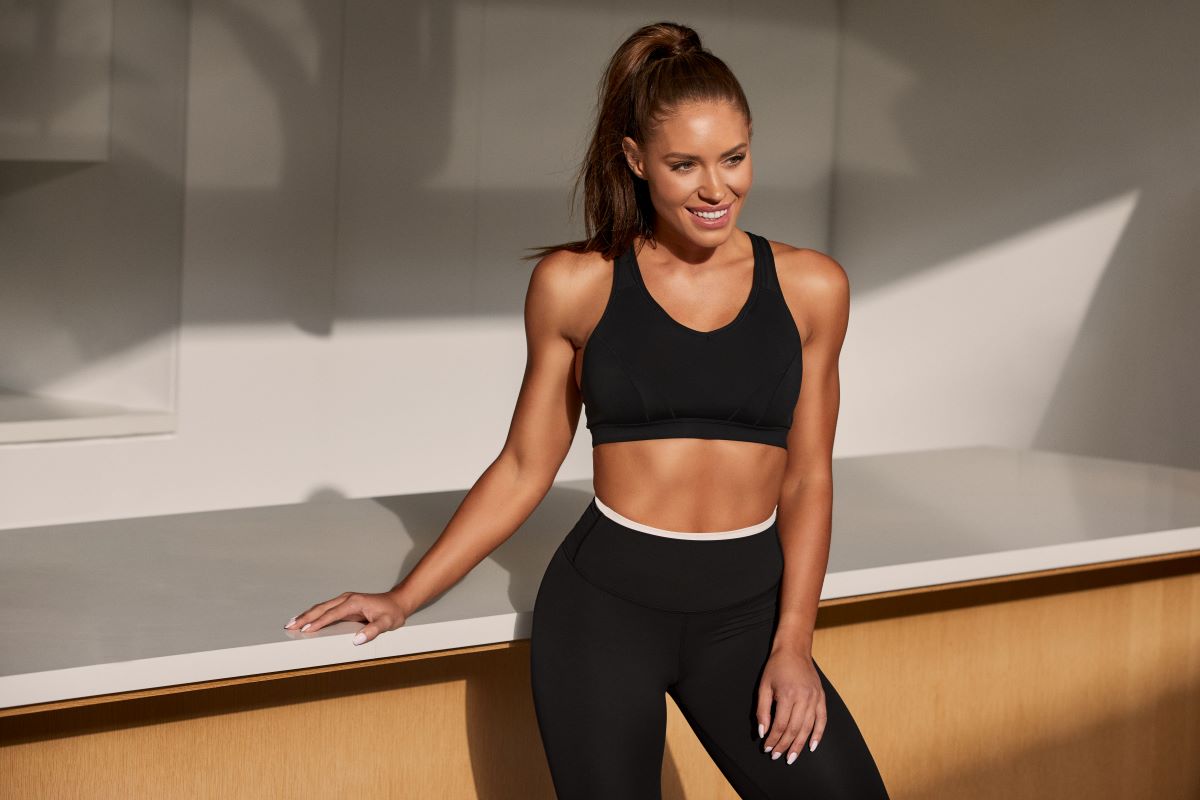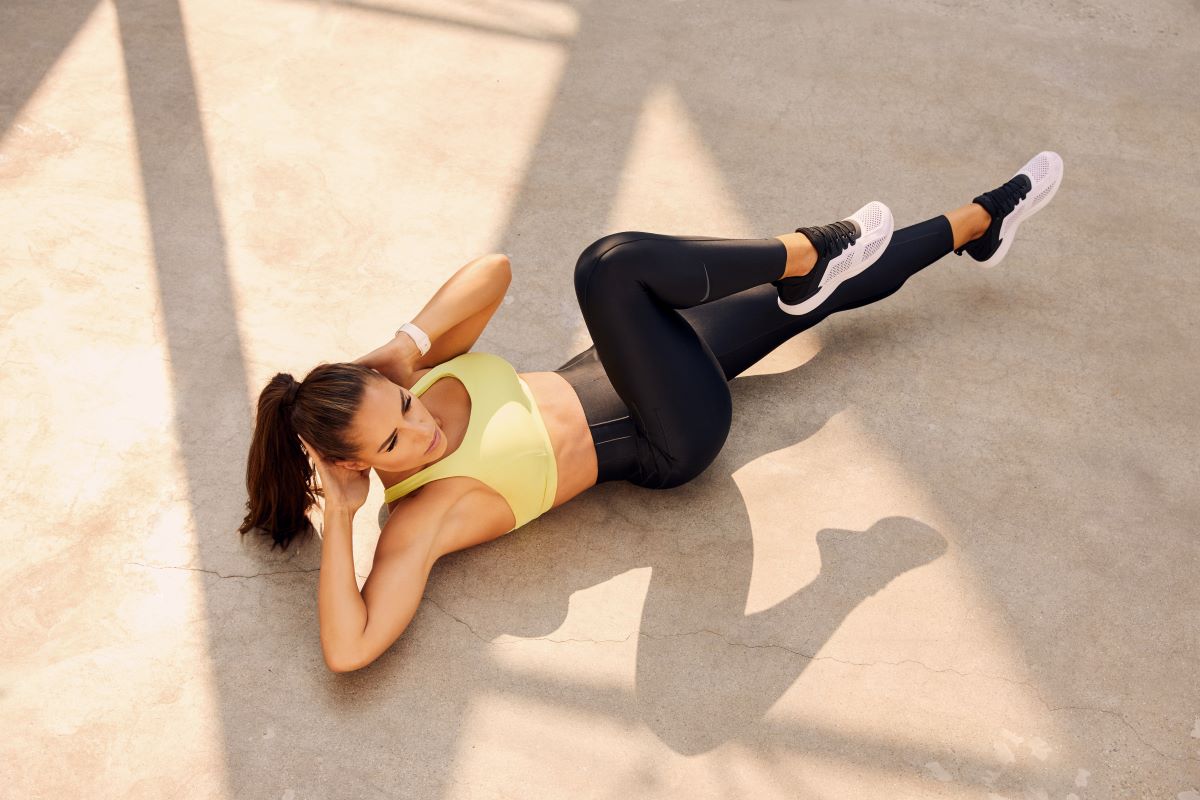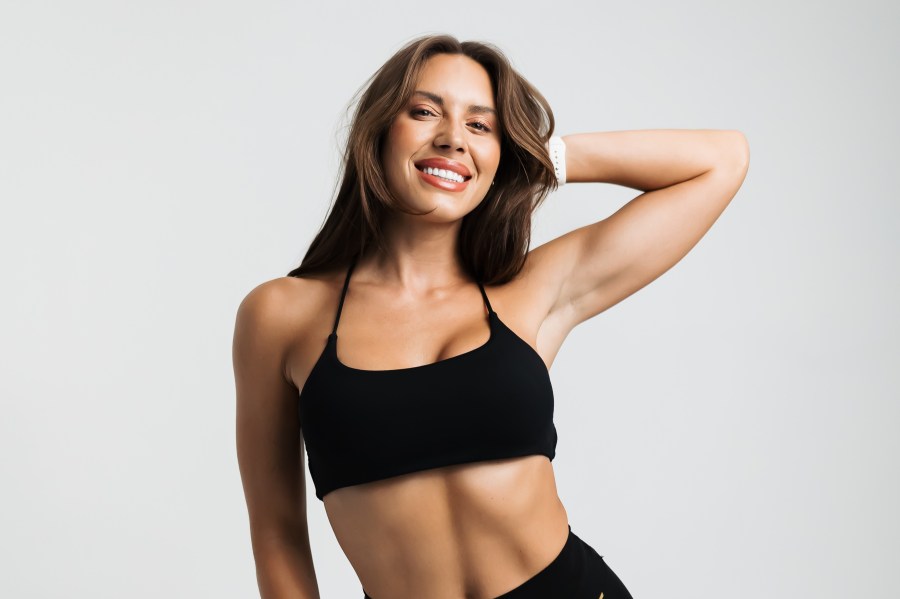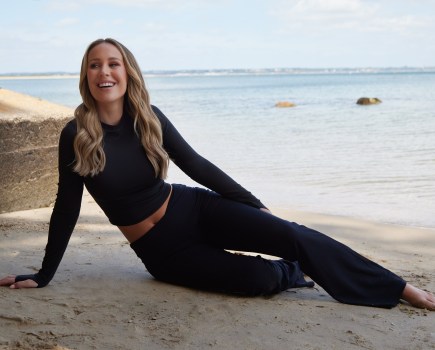As one of the world’s most famous trainers and influencers, Kelsey Wells knows a thing or two about fitness. She speaks to Lucy Gornall about accepting her body postpartum, plus how she adapted to a new type of workout after her ski injury.
World-renowned trainer Kelsey Wells is one of those people you can’t help but admire. She’s just so beautifully authentic; what you see is what you get. She’s amassed an impressive three million followers on Instagram, and this isn’t only down to her easy-to-follow strength-based workout routines, but also her honest insight into daily life: the ups and downs, the struggles and the reality of certain situations, which are all too-often brushed under the carpet.
The American fitness idol, who resides in Utah, is famous for her eight weight-based PWR training programmes. There are on the Sweat app, founded by Kelsey’s close friend and worldwide fitness sensation, Kayla Itsines.
Kelsey also founded her Redefine Fitness: Strength and Mindfulness training method, after a skiing injury in January 2022 left her out of action for several months longer than she anticipated. As well as this, her Redefine Fitness Podcast is a haven for all things related to health, both mind and body. Explaining the podcast, Kelsey says: ‘It’s the time to reclaim fitness as the powerful tool for your own self-empowerment that it was always supposed to be.’
Finding fitness post-birth
In saying this, Kelsey’s love of fitness only really took off following the birth of her son Anderson, now nine, with husband Ryan Wells, 33, who she married in 2010. This was the catalyst for Kelsey’s entire career. After working on her fitness post-birth, she experienced first-hand how good it can feel to exercise and eat well. Fast forward several years, and she’s spreading her love of strength-based workouts to the world.
Chatting at a boutique hotel in Shoreditch, she’s all smiles, yet is keen to share the mental and physical battles she’s faced over the years. Self-love and female-empowerment fuel Kelsey’s empathetic and holistic approach to wellness.
‘I’m so into mindfulness and mindful movement,’ she says. And it was her injury that led her to having what she describes as an epiphany. Having to transition from higher impact exercise to low impact left Kelsey feeling ‘stronger, more energetic and more alive’, as she admits that prior to injury, she was doing too much. Now, she wants to share her story and give advice to others coming back from injury or childbirth.

‘I missed out on appreciating the miracle of growing a human inside of me then nursing him, all because I was so obsessively fixated on picking apart everything I hated about what had happened to my body.’
Kelsey Wells on learning to love her new body
The first programme Kelsey Wells ever launched was focused on post-partum fitness and health after she struggled to know what to do following the birth of Anderson in 2014. Her PWR-Post Pregnancy is a 24-week programme looking at rebuilding strength in the abdominals and pelvic region as well as correcting postural issues that may have arisen.
But Kelsey describes the pressure placed on women to get back in shape as “insane”. Her son’s birth triggered her desire to exercise regularly in a bid to get back into shape. However, looking back, she wishes things had been different. ‘What I would give to go back and not hate my body so much. I missed out on appreciating the miracle of growing a human inside of me then nursing him, all because I was so obsessively fixated with looking in the mirror and picking apart everything that was “wrong” and everything I hated about what had happened to my body. That is tragic.’
Challenging post-partum body standards
Now, Kelsey is passionate about speaking out about the pressure on women to return to their former physiques. ‘We have to call out how ridiculous the standard is. It’s not healthy and it’s not OK. It won’t ever change if we don’t start calling that out,’ she says.
But she feels it’s important to acknowledge these feelings women have to want to return to their former selves, and that we must be kind to ourselves. ‘The feelings are still valid. It’s difficult to look in the mirror and not recognise your body. It’s a difficult and all-encompassing thing to give up your physical fitness to and for your child. When you have a baby, everything changes. Your internal organs rearrange themselves and it takes up to 20 months for everything to go back to normal. So how can you expect your physical external self to bounce back quickly?’
Supporting your healing journey
That said, Kelsey reiterates how important it is to strengthen your body to aid healing after having a baby, but that you must avoid working out until you’re cleared by your doctor to exercise. ‘That’s the big one. The best thing you can do for your body is to rest and recover during those first delicate weeks. When you’ve got approval to exercise again, go gently and ease into this. I don’t care if you’re an Olympian, you cannot just jump back into what you were doing. Allow your healing to be at the forefront of your fitness priorities.’
‘It’s so important that you don’t try to go it alone. Trust a professional to guide you through this,’ says Kelsey. ‘It’s important to work closely with experts who can help you regain lost strength in your core and pelvic floor. Have your doctor check for diastasis recti and then only do exercises suitable to help with that when your separation is healed,’ advises Kelsey.
And although post-pregnancy workouts can feel slow, especially if you were doing high-intensity exercise beforehand, Kelsey encourages a switch in mindset, to help new mums on their fitness journey. ‘When you choose to exercise postpartum, get into that mindset of “My body just performed an absolute miracle” and “I’m choosing to allow my body to heal”. That is so powerful and will give you results faster.
A life-changing accident
Unless you’re a stranger to Kelsey’s social media, you’ll have followed the journey she underwent from being bed bound in January 2022, to slowly and gently returning to movement.
It was her second day on the slopes whilst skiing in Little Cottonwood Canyon, 15 minutes from home, when she veered off the groomed ski track onto powder and broke her ankle.
‘I was so scared of blowing out one of my knees, I remember feeling my knees and thinking it was a miracle I was OK. But when I stood up, my ankle was killing me.’
Originally thinking it was a bad sprain, it was only when she took herself to the sports medicine emergency clinic first thing the following Monday that she realised the full extent of her injury. ‘How can you even hurt an ankle in a ski boot? It’s like a cast already!’ she jokes.
Following surgery, Kelsey spent two weeks in a splint, bed bound. This then turned into six weeks in a hard cast before being put into a brace so she could start relearning how to walk.
‘Ultimately, whether it’s four weeks or a year, it sucks and it is valid to feel panicked, upset, angry and sad.’
Healing from an injury – mentally and physcially
Now, almost two years later and following a lot of physical and mental healing, Kelsey is still dealing with the aftermath. ‘Sometimes I still limp when I get up from sitting for an hour, or I wake up and my ankle really sore.’
Whilst the physical impact was testing, having to take time away from her fitness career took its toll on her mental wellbeing. ‘As hard as it was physically, it was 10 times harder mentally. The real healing happens in your mind. It’s true for everyone, it’s humbling.’
Ultimately, injury is so prevalent, in all areas of sport and fitness but it’s often out of sight, out of mind. ‘You don’t think about it or worry about it until it happens to you but when it happens, it’s all encompassing and impacts every facet of your life. I didn’t train at all for three months, so how I took care of myself was by resting. I now have a new level of empathy for people who are injured or returning from injury,’ she says.
Adjusting to a new normal
Kelsey shared her eye-opening and very real journey back to fitness online, however, the physical therapy she underwent was something she kept very private. ‘Injury is very, very individual,’ she says, urging anyone who is dealing with an injury to go to a physical therapist or PT and do ‘exactly what they say. Do not do more than that until they say you can. Even with me and upper body workouts, I couldn’t do the same as before. It still puts strain on my ankle!’
Whilst she can’t advise on the best ways to recover and heal physically, Kelsey urges anyone dealing with an injury to give themselves grace, and ease gently back into fitness, starting from the basics. As a true advocate of weightlifting and building strength, Kelsey was forced to lighten the load as her ankle recovered. But, as she discovered, the side effects of this were revolutionary.
Both her recovery and return to fitness were gradual. Previously, she had used weightlifting and pushing herself in the gym as a way of feeling good but she could no longer rely on that boost.
Prioritising rest
‘My new go-to tool was rest. Rest, recovery and rehab are so vital,’ she says, adding that it’s important to take just as much pride in resting up as you would in your normal training. And although it wasn’t an overnight process. Kelsey says the epiphany that really helped her was realising she did need to rest in order to heal. ‘Once I gained that understanding, that I needed time out, I was able to take just as much pride in rest, and wiggling my ankle in therapy, as I normally would pushing myself as hard as I can in the gym.’
Being forced to only do low-impact training for more than a year ‘changed everything for me. I had this huge epiphany, where I realised I could train low impact yet keep my physique and get stronger; it was mind blowing how amazing I felt; my body was so happy. I realised that before, I had been doing too much – I was now doing less than ever yet was feeling stronger, more energised and more alive.’

‘You don’t think about [injuring yourself] or worry about it until it happens to you but when it happens, it’s all encompassing and impacts every facet of your life.’
Back on track
These days she’s not squatting as much but she’s still progressing. ‘I’ll tell you one thing: people think lifting heavy or going hard at the gym is badass, and it is. But the most badass workouts I ever did were the first ones after the birth of my son, and the PT sessions wiggling my ankle after my injury. Those workouts took more strength and took more from me than any heavy weights ever did.’
Her attitude is admirable, and a stark reminder that no, we don’t need to be smashing every workout and hitting PBs every session. Sometimes, life throws you an unexpected curveball and you must adapt to it, working with your body.
‘Meeting yourself where you’re at is what real strength looks like. If you’re in a moment of life where your best doesn’t look the same as it used to, it doesn’t mean you regressed.
If life has torn you down, you’re going to have to repair and grow but you can come back stronger.’
Kelsey Wells’ top tips for a healthy diet
Ensure you are well hydrated. Think you need to drink more water? ‘Make one small change at a time until it becomes your new normal. Then, you can pick something else. For me, I started drinking water instead of Dr Pepper. I didn’t ban Dr Pepper but I got properly hydrated first. I aim for 2-4 litres of water every day.’
Eat fruit and veg. ‘Micronutrients matter; fruits and veg have so much goodness in them. I never restrict or limit those things. Focus from a mindset of abundance. Do not focus on what you cannot have or restrict food. Focus on giving your body more good stuff.’
Have adequate protein. ‘People focus so much on eating certain amounts of carbs and fats. Really, eating adequate amounts of protein is going to be more beneficial for you. You’ll feel satiated, you’ll heal and aid your body in growing stronger.’
Kelsey Wells’ gym bag essentials
Listening to music: ‘I’m loving all the Taylor Swift music. I also I love a good gym mix like my old, curated playlists on Apple Music for my PWR and PWR at home programmes.’
Resistance bands: ‘How I use my three brands depends on the programme and workout. I use resistance bands in some of my activation exercises and to increase the intensity of bodyweight moves. They’re particularly handy when I travel!’
Protein bars: ‘These are great if I’m in a rush. I love Power Crunch Bars. They’re so elite – they taste like chocolate bars. I love Barebells too.’
Kelsey Wells’ new PWR Fusion programme is available now on the Sweat App. Visit sweat.com to find out more. Follow Kelsey at instagram.com/kelseywells.
Words: Lucy Gornall. Images: Luke Wooden and Rachel Bernstein (lead image)







